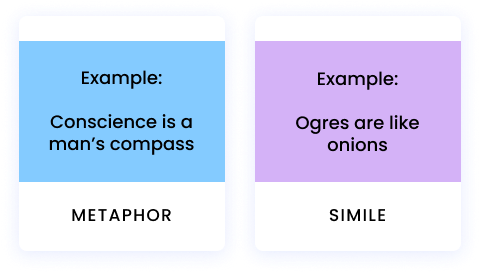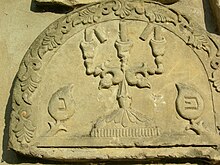Metaphor
According
to I.R.Galperin,the term ‘metaphor’, as the etymology of the word
reveals, means transference of some quality from one object to
another.Also the term has been known to denote the
transference of meaning from one word to another.
A
metaphor states A
is B
A
figure of speech in which an implied comparison is made between Two
unlike things that actually have something in common. A metaphor
expresses the unfamiliar (the tenor) in terms of the familiar (the
vehicle).When Neil Young sings, «Love is a rose», «rose»
is a vehicle for «love»,the tenor.
One
of the prominent examples of a metaphor in English literature is
the All
the world’s stage monologue
from As
you like it:
Ex:All
the world’s stage,
And
all the men and women merely players,
They
have their exits and their entrances
Metaphors
classified according to its degree and
unexpectedness: trite(dead) and
geniune(original).
Dead
metaphors
are fixed in dictionaries. they often sound banal like cliches:
Ex:to
burn with desire;a flight of imagination;
legs
of the table; winter comes.
Original
metaphors
are not registered in dictionaries. they are created by the
speaker’s/writer’s imagination and sound fresh and unexpected
Ex:Some
books are to be tasted, others swallowed, and some few to be chewed
and digested.;
The
house was a white
elephant
but he couldn’t conceive of his father in a smaller place.
— describes the size and enigma of the house.
Prolonged
or sustained metaphors.:
if a sentence contains a group of metaphors; consists of
principal(the central image of sustained metaphor) and contributory
images(the other words which bear reference to the central image)
Ex.Mr
. Pickwick bottled up his vengeance and corked it down. The verb to
bottle up is explained in dictionaries as follows ‘to keep in
check’,’conceal,restrain,repress.The metaphor in the word can
hardly be felt.But it is revived by the direct meaning of the verb
‘to cork down’.This context refreshes the almost dead metaphor
and gives it a second life.Such metaphors are called sustained or
prolonged.
Metaphors
are used to help us understand the unknown, because we use what we
know in comparison with something we don’t know to get a better
understanding of the unknown.
Metonymy.
A
figure of speech in which one word or phrase is substituted for
another with which it is closely associated (such as «crown»
for «royalty»).
Trite
(fixed) metonymy
represents derivative logical meaning of a word and is fixed in
dictionaries. ▲ Nothing
comes between me and my Calvins
(Calvin Klein Jeans). Contextual
m.
– unexpected substitution of one word to another. ▲ She
married into conversation
> very talkative man.
The
examples below include both the metonymy and the possible words for
which the metonymy would fill in:
-
Crown
— in place of a royal person -
The
White House — in place of the President or others who work there -
The
White House asked the television networks for air time on Monday
night. -
The
suits — in place of business people -
Dish
— for an entire plate of food -
Cup — for
a mug -
The
Pentagon — to refer to the staff -
The
restaurant — to refer to the staff
Соседние файлы в предмете [НЕСОРТИРОВАННОЕ]
- #
- #
- #
- #
- #
- #
- #
- #
- #
- #
- #
A metaphor is a figure of speech that, for rhetorical effect, directly refers to one thing by mentioning another.[1] It may provide (or obscure) clarity or identify hidden similarities between two different ideas. Metaphors are often compared with other types of figurative language, such as antithesis, hyperbole, metonymy, and simile.[2] One of the most commonly cited examples of a metaphor in English literature comes from the «All the world’s a stage» monologue from As You Like It:
All the world’s a stage,
And all the men and women merely players;
They have their exits and their entrances
And one man in his time plays many parts,
His Acts being seven ages. At first, the infant…
—William Shakespeare, As You Like It, 2/7[3]
This quotation expresses a metaphor because the world is not literally a stage, and most humans are not literally actors and actresses playing roles. By asserting that the world is a stage, Shakespeare uses points of comparison between the world and a stage to convey an understanding about the mechanics of the world and the behavior of the people within it.
In the ancient Hebrew psalms (around 1000 B.C.), one finds already vivid and poetic examples of metaphor such as, «The Lord is my rock, my fortress and my deliverer; my God is my rock, in whom I take refuge, my shield and the horn of my salvation, my stronghold» and «The Lord is my shepherd, I shall not want». Some recent linguistic theories view all language in essence as metaphorical.[4]
The word metaphor itself is a metaphor, coming from a Greek term meaning «transference (of ownership)». The user of a metaphor alters the reference of the word, «carrying» it from one semantic «realm» to another. The new meaning of the word might be derived from an analogy between the two semantic realms, but also from other reasons such as the distortion of the semantic realm — for example in sarcasm.
Etymology[edit]
The English word metaphor derives from the 16th-century Old French word métaphore, which comes from the Latin metaphora, «carrying over», and in turn from the Greek μεταφορά (metaphorá), «transference (of ownership)»,[5] from μεταφέρω (metapherō), «to carry over», «to transfer»[6] and that from μετά (meta), «behind», «along with», «across»[7] + φέρω (pherō), «to bear», «to carry».[8]
Parts of a metaphor[edit]
The Philosophy of Rhetoric (1937) by rhetorician I. A. Richards describes a metaphor as having two parts: the tenor and the vehicle. The tenor is the subject to which attributes are ascribed. The vehicle is the object whose attributes are borrowed. In the previous example, «the world» is compared to a stage, describing it with the attributes of «the stage»; «the world» is the tenor, and «a stage» is the vehicle; «men and women» is the secondary tenor, and «players» is the secondary vehicle.
Other writers[which?] employ the general terms ‘ground’ and ‘figure’ to denote the tenor and the vehicle. Cognitive linguistics uses the terms ‘target’ and ‘source’, respectively.
Psychologist Julian Jaynes coined the terms ‘metaphrand’ and ‘metaphier’, plus two new concepts, ‘paraphrand’ and ‘paraphier’.[9]
[10]
‘Metaphrand’ is equivalent to the metaphor-theory terms ‘tenor’, ‘target’, and ‘ground’. ‘Metaphier’ is equivalent to the metaphor-theory terms ‘vehicle’, ‘figure’, and ‘source’. In a simple metaphor, an obvious attribute of the metaphier exactly characterizes the metaphrand (e.g. the ship plowed the seas). With an inexact metaphor, however, a metaphier might have associated attributes or nuances – its paraphiers – that enrich the metaphor because they «project back» to the metaphrand, potentially creating new ideas – the paraphrands – associated thereafter with the metaphrand or even leading to a new metaphor. For example, in the metaphor «Pat is a tornado», the metaphrand is «Pat», the metaphier is «tornado». As metaphier, «tornado» carries paraphiers such as power, storm and wind, counterclockwise motion, and danger, threat, destruction, etc. The metaphoric meaning of «tornado» is inexact: one might understand that ‘Pat is powerfully destructive’ through the paraphrand of physical and emotional destruction; another person might understand the metaphor as ‘Pat can spin out of control’. In the latter case, the paraphier of ‘spinning motion’ has become the paraphrand ‘psychological spin’, suggesting an entirely new metaphor for emotional unpredictability, a possibly apt description for a human being hardly applicable to a tornado.
Based on his analysis, Jaynes claims that metaphors not only enhance description, but «increase enormously our powers of perception…and our understanding of [the world], and literally create new objects».[9]: 50
As a type of comparison[edit]
Metaphors are most frequently compared with similes. It is said, for instance, that a metaphor is ‘a condensed analogy’ or ‘analogical fusion’ or that they ‘operate in a similar fashion’ or are ‘based on the same mental process’ or yet that ‘the basic processes of analogy are at work in metaphor’. It is also pointed out that ‘a border between metaphor and analogy is fuzzy’ and ‘the difference between them might be described (metaphorically) as the distance between things being compared’. A metaphor asserts the objects in the comparison are identical on the point of comparison, while a simile merely asserts a similarity through use of words such as «like» or «as». For this reason a common-type metaphor is generally considered more forceful than a simile.[11][12]
The metaphor category contains these specialized types:
- Allegory: An extended metaphor wherein a story illustrates an important attribute of the subject.
- Antithesis: A rhetorical contrast of ideas by means of parallel arrangements of words, clauses, or sentences.[13]
- Catachresis: A mixed metaphor, sometimes used by design and sometimes by accident (a rhetorical fault).
- Hyperbole: Excessive exaggeration to illustrate a point.[14]
- Parable: An extended metaphor told as an anecdote to illustrate or teach a moral or spiritual lesson, such as in Aesop’s fables or Jesus’ teaching method as told in the Bible.
- Pun: A verbal device by which multiple definitions of a word or its homophones are used to give a sentence multiple valid readings, typically to humorous effect.
- Similitude: An extended simile or metaphor that has a picture part (Bildhälfte), a reality part (Sachhälfte), and a point of comparison (tertium comparationis).[15] Similitudes are found in the parables of Jesus.
Metaphor vs metonymy[edit]
Metaphor is distinct from metonymy, both constituting two fundamental modes of thought. Metaphor works by bringing together concepts from different conceptual domains, whereas metonymy uses one element from a given domain to refer to another closely related element. A metaphor creates new links between otherwise distinct conceptual domains, whereas a metonymy relies on pre-existent links within them.
For example, in the phrase «lands belonging to the crown», the word «crown» is a metonymy because some monarchs do indeed wear a crown, physically. In other words, there is a pre-existent link between «crown» and «monarchy».[16] On the other hand, when Ghil’ad Zuckermann argues that the Israeli language is a «phoenicuckoo cross with some magpie characteristics», he is using a metaphor.[17]: 4 There is no physical link between a language and a bird. The reason the metaphors «phoenix» and «cuckoo» are used is that on the one hand hybridic «Israeli» is based on Hebrew, which, like a phoenix, rises from the ashes; and on the other hand, hybridic «Israeli» is based on Yiddish, which like a cuckoo, lays its egg in the nest of another bird, tricking it to believe that it is its own egg. Furthermore, the metaphor «magpie» is employed because, according to Zuckermann, hybridic «Israeli» displays the characteristics of a magpie, «stealing» from languages such as Arabic and English.[17]: 4–6
Subtypes[edit]
A dead metaphor is a metaphor in which the sense of a transferred image has become absent. The phrases «to grasp a concept» and «to gather what you’ve understood» use physical action as a metaphor for understanding. The audience does not need to visualize the action; dead metaphors normally go unnoticed. Some distinguish between a dead metaphor and a cliché. Others use «dead metaphor» to denote both.[18]
A mixed metaphor is a metaphor that leaps from one identification to a second inconsistent with the first, e.g.:
I smell a rat […] but I’ll nip him in the bud» — Irish politician Boyle Roche
This form is often used as a parody of metaphor itself:
If we can hit that bull’s-eye then the rest of the dominoes will fall like a house of cards… Checkmate.
An extended metaphor, or conceit, sets up a principal subject with several subsidiary subjects or comparisons. In the above quote from As You Like It, the world is first described as a stage and then the subsidiary subjects men and women are further described in the same context.
An implicit metaphor has no specified tenor, although the vehicle is present. M. H. Abrams offers the following as an example of an implicit metaphor: «That reed was too frail to survive the storm of its sorrows». The reed is the vehicle for the implicit tenor, someone’s death, and the «storm» is the vehicle for the person’s «sorrows».[20]
Metaphor can serve as a device for persuading an audience of the user’s argument or thesis, the so-called rhetorical metaphor.
In rhetoric and literature[edit]
Aristotle writes in his work the Rhetoric that metaphors make learning pleasant: «To learn easily is naturally pleasant to all people, and words signify something, so whatever words create knowledge in us are the pleasantest.»[21] When discussing Aristotle’s Rhetoric, Jan Garret stated «metaphor most brings about learning; for when [Homer] calls old age «stubble», he creates understanding and knowledge through the genus, since both old age and stubble are [species of the genus of] things that have lost their bloom.»[22] Metaphors, according to Aristotle, have «qualities of the exotic and the fascinating; but at the same time we recognize that strangers do not have the same rights as our fellow citizens».[23]
Educational psychologist Andrew Ortony gives more explicit detail: «Metaphors are necessary as a communicative device because they allow the transfer of coherent chunks of characteristics — perceptual, cognitive, emotional and experiential — from a vehicle which is known to a topic which is less so. In so doing they circumvent the problem of specifying one by one each of the often unnameable and innumerable characteristics; they avoid discretizing the perceived continuity of experience and are thus closer to experience and consequently more vivid and memorable.»[24]
As style in speech and writing[edit]
As a characteristic of speech and writing, metaphors can serve the poetic imagination. This allows Sylvia Plath, in her poem «Cut», to compare the blood issuing from her cut thumb to the running of a million soldiers, «redcoats, every one»; and enabling Robert Frost, in «The Road Not Taken», to compare a life to a journey.[25][26][27]
Metaphors can be implied and extended throughout pieces of literature.
Larger applications[edit]
Sonja K. Foss characterizes metaphors as «nonliteral comparisons in which a word or phrase from one domain of experience is applied to another domain».[28]
She argues that since reality is mediated by the language we use to describe it, the metaphors we use shape the world and our interactions to it.
A metaphorical visualization of the word anger.
The term metaphor is used to describe more basic or general aspects of experience and cognition:
- A cognitive metaphor is the association of object to an experience outside the object’s environment
- A conceptual metaphor is an underlying association that is systematic in both language and thought
- A root metaphor is the underlying worldview that shapes an individual’s understanding of a situation
- A nonlinguistic metaphor is an association between two nonlinguistic realms of experience
- A visual metaphor uses an image to create the link between different ideas
Conceptual metaphors[edit]
Some theorists have suggested that metaphors are not merely stylistic, but that they are cognitively important as well. In Metaphors We Live By, George Lakoff and Mark Johnson argue that metaphors are pervasive in everyday life, not just in language, but also in thought and action. A common definition of metaphor can be described as a comparison that shows how two things that are not alike in most ways are similar in another important way. They explain how a metaphor is simply understanding and experiencing one kind of thing in terms of another, called a «conduit metaphor». A speaker can put ideas or objects into containers, and then send them along a conduit to a listener who removes the object from the container to make meaning of it. Thus, communication is something that ideas go into, and the container is separate from the ideas themselves. Lakoff and Johnson give several examples of daily metaphors in use, including «argument is war» and «time is money». Metaphors are widely used in context to describe personal meaning. The authors suggest that communication can be viewed as a machine: «Communication is not what one does with the machine, but is the machine itself.»[29]
Experimental evidence shows that «priming» people with material from one area will influence how they perform tasks and interpret language in a metaphorically related area.[note 1]
As a foundation of our conceptual system[edit]
Cognitive linguists emphasize that metaphors serve to facilitate the understanding of one conceptual domain—typically an abstraction such as «life», «theories» or «ideas»—through expressions that relate to another, more familiar conceptual domain—typically more concrete, such as «journey», «buildings» or «food».[31][32] For example: we devour a book of raw facts, try to digest them, stew over them, let them simmer on the back-burner, regurgitate them in discussions, and cook up explanations, hoping they do not seem half-baked.
A convenient short-hand way of capturing this view of metaphor is the following: CONCEPTUAL DOMAIN (A) IS CONCEPTUAL DOMAIN (B), which is what is called a conceptual metaphor. A conceptual metaphor consists of two conceptual domains, in which one domain is understood in terms of another. A conceptual domain is any coherent organization of experience. For example, we have coherently organized knowledge about journeys that we rely on in understanding life.[32]
Lakoff and Johnson greatly contributed to establishing the importance of conceptual metaphor as a framework for thinking in language, leading scholars to investigate the original ways in which writers used novel metaphors and question the fundamental frameworks of thinking in conceptual metaphors.
From a sociological, cultural, or philosophical perspective, one asks to what extent ideologies maintain and impose conceptual patterns of thought by introducing, supporting, and adapting fundamental patterns of thinking metaphorically.[33] To what extent does the ideology fashion and refashion the idea of the nation as a container with borders? How are enemies and outsiders represented? As diseases? As attackers? How are the metaphoric paths of fate, destiny, history, and progress represented? As the opening of an eternal monumental moment (German fascism)? Or as the path to communism (in Russian or Czech for example)?[citation needed]
Some cognitive scholars have attempted to take on board the idea that different languages have evolved radically different concepts and conceptual metaphors, while others hold to the Sapir-Whorf hypothesis. German philologist Wilhelm von Humboldt contributed significantly to this debate on the relationship between culture, language, and linguistic communities. Humboldt remains, however, relatively unknown in English-speaking nations. Andrew Goatly, in «Washing the Brain», takes on board the dual problem of conceptual metaphor as a framework implicit in the language as a system and the way individuals and ideologies negotiate conceptual metaphors. Neural biological research suggests some metaphors are innate, as demonstrated by reduced metaphorical understanding in psychopathy.[34]
James W. Underhill, in Creating Worldviews: Ideology, Metaphor & Language (Edinburgh UP), considers the way individual speech adopts and reinforces certain metaphoric paradigms. This involves a critique of both communist and fascist discourse. Underhill’s studies are situated in Czech and German, which allows him to demonstrate the ways individuals are thinking both within and resisting the modes by which ideologies seek to appropriate key concepts such as «the people», «the state», «history», and «struggle».
Though metaphors can be considered to be «in» language, Underhill’s chapter on French, English and ethnolinguistics demonstrates that we cannot conceive of language or languages in anything other than metaphoric terms.
Nonlinguistic metaphors[edit]
Tombstone of a Jewish woman depicting broken candles, a visual metaphor of the end of life.
Metaphors can map experience between two nonlinguistic realms. Musicologist Leonard B. Meyer demonstrated how purely rhythmic and harmonic events can express human emotions.[35] It is an open question whether synesthesia experiences are a sensory version of metaphor, the «source» domain being the presented stimulus, such as a musical tone, and the target domain, being the experience in another modality, such as color.[36]
Art theorist Robert Vischer argued that when we look at a painting, we «feel ourselves into it» by imagining our body in the posture of a nonhuman or inanimate object in the painting. For example, the painting The Lonely Tree by Caspar David Friedrich shows a tree with contorted, barren limbs.[37][38] Looking at the painting, we imagine our limbs in a similarly contorted and barren shape, evoking a feeling of strain and distress. Nonlinguistic metaphors may be the foundation of our experience of visual and musical art, as well as dance and other art forms.[39][40]
In historical linguistics[edit]
In historical onomasiology or in historical linguistics, a metaphor is defined as a semantic change based on a similarity in form or function between the original concept and the target concept named by a word.[41]
For example, mouse: small, gray rodent with a long tail → small, gray computer device with a long cord.
Some recent linguistic theories view all language in essence as metaphorical.[42]
Historical theories[edit]
Aristotle discusses the creation of metaphors at the end of his Poetics: «But the greatest thing by far is to be a master of metaphor. It is the one thing that cannot be learnt from others; and it is also a sign of genius, since a good metaphor implies an intuitive perception of the similarity in dissimilars.»[43]
Baroque literary theorist Emanuele Tesauro defines the metaphor «the most witty and acute, the most strange and marvelous, the most pleasant and useful, the most eloquent and fecund part of the human intellect». There is, he suggests, something divine in metaphor: the world itself is God’s poem[44] and metaphor is not just a literary or rhetorical figure but an analytic tool that can penetrate the mysteries of God and His creation.[45]
Friedrich Nietzsche makes metaphor the conceptual center of his early theory of society in On Truth and Lies in the Non-Moral Sense.[46] Some sociologists have found his essay useful for thinking about metaphors used in society and for reflecting on their own use of metaphor. Sociologists of religion note the importance of metaphor in religious worldviews, and that it is impossible to think sociologically about religion without metaphor.[47]
See also[edit]
- Alliteration
- Camel’s nose
- Colemanballs
- Conceptual blending
- Description
- Experience model
- Hypocatastasis
- Ideasthesia
- List of English-language metaphors
- Literal and figurative language
- Metaphor identification procedure
- Metaphor in philosophy
- Metonymy
- Misnomer
- Origin of language
- Origin of speech
- Pataphor
- Personification
- Reification (fallacy)
- Sarcasm
- Simile
- Synecdoche
- Analogy
- Tertium comparationis
- War as metaphor
- World Hypotheses
Notes[edit]
- ^ «In sum, there are now numerous results from comprehension-oriented studies suggesting that (1) comprehending metaphorical language activates concrete source domain concepts, and that (2) activating particular concrete perceptual or motor knowledge affects subsequent reasoning and language comprehension about a metaphorically connected abstract domain»[30]
References[edit]
Citations[edit]
- ^ Compare: «Definition of METAPHOR». www.merriam-webster.com. Retrieved 29 March 2016.
[…] a figure of speech in which a word or phrase literally denoting one kind of object or idea is used in place of another to suggest a likeness or analogy between them [… .]
- ^ The Oxford Companion to The English Language, 2nd Edition (e-book). Oxford University Press. 2018. ISBN 978-0-19-107387-8.
- ^ «As You Like It: Entire Play». Shakespeare.mit.edu. Retrieved 4 March 2012.
- ^ «Radio 4 – Reith Lectures 2003 – The Emerging Mind». BBC. Retrieved 4 March 2012.
- ^ μεταφορά Archived 6 July 2007 at the Wayback Machine, Henry George Liddell, Robert Scott, A Greek-English Lexicon, on Perseus.
- ^ cdasc3D%2367010 μεταφέρω, Henry George Liddell, Robert Scott, A Greek-English Lexicon, on Perseus.
- ^ μετά Archived 29 March 2008 at the Wayback Machine, Henry George Liddell, Robert Scott, A Greek-English Lexicon, on Perseus.
- ^ φέρω Archived 12 September 2007 at the Wayback Machine, Henry George Liddell, Robert Scott, A Greek-English Lexicon, on Perseus.
- ^ a b Jaynes, Julian (2000) [1976]. The Origin of Consciousness in the Breakdown of the Bicameral Mind (PDF). Houghton Mifflin. ISBN 0-618-05707-2. Archived from the original (PDF) on 7 August 2019. Retrieved 24 October 2019.
- ^ Pierce, Dann L. (2003). «Chapter Five». Rhetorical Criticism and Theory in Practice. McGraw-Hill. ISBN 9780072500875.
- ^ The Oxford Companion to the English Language (1992) pp.653
- ^ The Columbia Encyclopedia (6th edition)
- ^ «Definition of ANTITHESIS».
- ^ «Definition of HYPERBOLE».
- ^ Adolf Jülicher, Die Gleichnisreden Jesu, 2nd ed (Tübingen: J. C. B. Mohr, 1910).
- ^ «Definition of METONYMY».
- ^ a b Zuckermann, Ghil’ad (2020). Revivalistics: From the Genesis of Israeli to Language Reclamation in Australia and Beyond. New York: Oxford University Press. ISBN 9780199812790.
- ^ Barker, P. (2000). «Working with the metaphor of life and death». Medical Humanities. 26 (2): 97–102. doi:10.1136/mh.26.2.97. PMID 23670145. S2CID 25309973. Archived from the original on 2 February 2019. Retrieved 1 February 2019.
- ^ «Zapp Brannigan (Character)». IMDb. Retrieved 21 September 2014.
- ^ M. H. Abrams and Geoffrey Galt Harpham, A Glossary of Literary Terms, 11th ed. (Stamford, CT: Cengage Learning, 2015), 134.
- ^ Aristotle, W. Rhys Roberts, Ingram Bywater, and Friedrich Solmsen. Rhetoric. New York: Modern Library, 1954. Print.
- ^ Garret, Jan. «Aristotle on Metaphor.» , Excerpts from Poetics and Rhetoric. N.p., 28 March 2007. Web. 29 Sept. 2014.
- ^ Moran, Richard. 1996. Artifice and persuasion: The work of metaphor in the rhetoric. In Essays on Aristotle’s rhetoric, ed. Amelie Oksenberg Rorty, 385–398. Berkeley: University of California Press.
- ^ Ortony, Andrew (Winter 1975). «Why metaphors are necessary and not just nice». Educational Theory. 25 (1): 45–53. doi:10.1111/j.1741-5446.1975.tb00666.x.
- ^ «Cut». Sylvia Plath Forum. Retrieved 4 March 2012.
- ^ «Sylvia Plath Forum: Home page». www.sylviaplathforum.com. Archived from the original on 12 September 2010.
- ^ «1. The Road Not Taken. Frost, Robert. 1920. Mountain Interval». Bartleby.com. Retrieved 4 March 2012.
- ^
Foss, Sonja K. (1988). Rhetorical Criticism: Exploration and Practice (4 ed.). Long Grove, Illinois: Waveland Press (published 2009). p. 249. ISBN 9781577665861. Retrieved 4 October 2018. - ^ Lakoff, G. & Johnson, M. Metaphors We Live By (IL: University of Chicago Press, 1980), Chapters 1–3. (pp. 3–13).
- ^ Sato, Manami; Schafer, Amy J.; Bergen, Benjamin K. (2015). «Metaphor priming in sentence production: Concrete pictures affect abstract language production». Acta Psychologica. 156: 136–142. doi:10.1016/j.actpsy.2014.09.010. ISSN 0001-6918. PMID 25443987.
- ^ Lakoff G.; Johnson M. (2003) [1980]. Metaphors We Live By. Chicago: University of Chicago Press. ISBN 978-0-226-46801-3.
- ^ a b Zoltán Kövecses. (2002) Metaphor: a practical introduction. Oxford University Press US. ISBN 978-0-19-514511-3.
- ^ McKinnon, AM. (2013). ‘Ideology and the Market Metaphor in Rational Choice Theory of Religion: A Rhetorical Critique of «Religious Economies»‘. Critical Sociology, vol 39, no. 4, pp. 529-543.[1] Archived 12 November 2014 at the Wayback Machine
- ^ Meier, Brian P.; et al. (September 2007). «Failing to take the moral high ground: Psychopathy and the vertical representation of morality». Personality and Individual Differences. 43 (4): 757–767. doi:10.1016/j.paid.2007.02.001. Retrieved 1 November 2016.
- ^ Meyer, L. (1956) Emotion and Meaning in Music. Chicago: University of Chicago Press
- ^ Blechner, M. (2018) The Mindbrain and Dreams: An Exploration of Dreaming, Thinking, and Artistic Creation. NY: Routledge
- ^ Blechner, M. (1988) Differentiating empathy from therapeutic action. Contemporary Psychoanalysis, 24:301–310.
- ^ Vischer, R. (1873) Über das optische Formgefühl: Ein Beitrag zur Aesthetik. Leipzig: Hermann Credner. For an English translation of selections, see Wind, E. (1963) Art and Anarchy. London: Faber and Faber.
- ^ Johnson, M. & Larson, S. (2003) «Something in the way she moves» – Metaphors of musical motion. Metaphor and Symbol, 18:63–84
- ^ Whittock, T. (1992) The role of metaphor in dance. British Journal of Aesthetics, 32:242–249.
- ^ Cf. Joachim Grzega (2004), Bezeichnungswandel: Wie, Warum, Wozu? Ein Beitrag zur englischen und allgemeinen Onomasiologie, Heidelberg: Winter, and Blank, Andreas (1997), Prinzipien des lexikalischen Bedeutungswandels am Beispiel der romanischen Sprachen, Tübingen: Niemeyer.
- ^ «Radio 4 – Reith Lectures 2003 – The Emerging Mind». BBC. Retrieved 4 March 2012.
- ^ Cf. The Rhetoric and Poetics of Aristotle, ed. Friedrich Solmsen (New York: Random House, 1954), 1459a 5–8.
- ^ Cassell Dictionary Italian Literature. Bloomsbury Academic. 1996. p. 578. ISBN 9780304704644.
- ^ Sohm, Philip (1991). Pittoresco. Marco Boschini, His Critics, and Their Critiques of Painterly Brushwork in Seventeenth- and Eighteenth-Century Italy. Cambridge University Press. p. 126. ISBN 9780521382564.
- ^ «T he Nietzsche Channel: On Truth and Lie in an Extra-Moral Sense». oregonstate.edu.
- ^ McKinnon, A. M. (2012). «Metaphors in and for the Sociology of Religion: Towards a Theory after Nietzsche» (PDF). Journal of Contemporary Religion. pp. 203–216.
Sources[edit]
- This article incorporates material from the Citizendium article «Metaphor», which is licensed under the Creative Commons Attribution-ShareAlike 3.0 Unported License but not under the GFDL.
- Stefano Arduini (2007). (ed.) Metaphors, Roma, Edizioni di Storia e Letteratura.
- Aristotle. Poetics. Trans. I. Bywater. In The Complete Works of Aristotle: The Revised Oxford Translation. (1984). 2 Vols. Ed. Jonathan Barnes. Princeton, NJ: Princeton University Press.
- Max Black (1954). Metaphor, Proceedings of the Aristotelian Society, 55, pp. 273–294.
- Max Black (1962). Models and metaphors: Studies in language and philosophy, Ithaca: Cornell University Press.
- Max Black (1979). More about Metaphor, in A. Ortony (ed) Metaphor & Thought.
- Clive Cazeaux (2007). Metaphor and Continental Philosophy: From Kant to Derrida. New York, NY: Routledge.
- L. J. Cohen (1979). The Semantics of Metaphor, in A. Ortony (ed.), Metaphor & Thought.
- Donald Davidson. (1978). «What Metaphors Mean.» Reprinted in Inquiries into Truth and Interpretation. (1984). Oxford, England: Oxford University Press.
- Jacques Derrida (1982). «White Mythology: Metaphor in the Text of Philosophy.» In Margins of Philosophy. Trans. Alan Bass. Chicago, University of Chicago Press.
- René Dirvens; Ralf Pörings, eds. (2002). Metaphor and Metonymy in Contrast. Berlin.: Mouton de Gruyter.
- Fass, Dan (1988). «Metonymy and metaphor: what’s the difference?». Proceedings of the 12th conference on Computational linguistics. Vol. 1. pp. 177–81. doi:10.3115/991635.991671. ISBN 978-963-8431-56-1. S2CID 9557558.
- Jakobson, Roman (1990). «Two Aspects of Language and Two Types of Aphasic Disturbances». In Linda Waugh; Monique Monville-Burston (eds.). On Language. Cambridge, MA: Harvard University Press. pp. 115–133. ISBN 978-0-674-63536-4.
- Lakoff, G. & Johnson, M. Metaphors We Live By (IL: University of Chicago Press, 1980), Chapters 1–3. (pp. 3–13).
- Lakoff, George (1980). Metaphors We Live By. Chicago, IL: The University of Chicago Press. ISBN 978-0-226-46801-3..
- Low, Graham (11 February 1999). «An Essay is a Person». In Cameron, Lynne; Low, Graham (eds.). Researching and Applying Metaphor. Cambridge, England: Cambridge University Press. pp. 221–48. ISBN 978-0-521-64964-3.
- Peters, Wim (2003). «Metonymy as a cross-lingual phenomenon». Proceedings of the ACL 2003 workshop on Lexicon and figurative language. Vol. 14. pp. 1–9. doi:10.3115/1118975.1118976. S2CID 8267864.
- McKinnon, AM. (2012). ‘Metaphors in and for the Sociology of Religion: Towards a Theory after Nietzsche’. Journal of Contemporary Religion, vol 27, no. 2, pp. 203–216. [2] Archived 18 August 2014 at the Wayback Machine
- David Punter (2007). Metaphor, London, Routledge.
- Paul Ricoeur (1975). The Rule of Metaphor: Multi-Disciplinary Studies in the Creation of Meaning in Language, trans. Robert Czerny with Kathleen McLaughlin and John Costello, S. J., London: Routledge and Kegan Paul 1978. (Toronto: University of Toronto Press 1977)
- I. A. Richards. (1936). The Philosophy of Rhetoric. Oxford, Oxford University Press.
- John Searle (1979). «Metaphor,» in A. Ortony (ed.) Metaphor and Thought, Cambridge University Press.
- Underhill, James W., Creating Worldviews: Metaphor, Ideology & Language, Edinburgh UP, 2011.
- Herscberger, Ruth (Summer 1943). «The Structure of Metaphor». The Kenyan Review. 5 (3): 433–443. JSTOR 4332426.
- Rudmin, Floyd W. (1991). «Having: A Brief History of Metaphor and Meaning». Syracuse Law Review. 42: 163. Retrieved 11 October 2013.
- Somov, Georgij Yu (2013). «The interrelation of metaphors and metonymies in sign systems of visual art: An example analysis of works by V. I. Surikov». Semiotica. 2013 (193): 31–66. doi:10.1515/sem-2013-0003.
External links[edit]
Look up metaphor in Wiktionary, the free dictionary.
Wikiquote has quotations related to Metaphors.
Wikimedia Commons has media related to Metaphors.
- History of metaphor on In Our Time at the BBC
- A short history of metaphor
- Audio illustrations of metaphor as figure of speech
- Top Ten Metaphors of 2008
- Shakespeare’s Metaphors
- Definition and Examples
- Metaphor Examples (categorized)
- List of ancient Greek words starting with μετα-, on Perseus
- Metaphor and Phenomenology article in the Internet Encyclopedia of Philosophy
- Metaphors algebra
- Pérez-Sobrino, Paula (2014). «Meaning construction in verbomusical environments: Conceptual disintegration and metonymy» (PDF). Journal of Pragmatics. 70: 130–151. doi:10.1016/j.pragma.2014.06.008.
If I were a bit dramatic, I’d start this piece with the following line: chaos is a friend of mine.
Except, chaos isn’t a friend of mine – there’s no chaos wherever I go (thankfully 😅). And, I’m also not as dramatic. What I want to do though, is to introduce you to a metaphor in the first line itself.
It got your attention, didn’t it?
Because that’s how metaphors work. They stroke your imagination, drawing beautiful comparisons between two apparently unrelated things or ideas. Here are a few more simple metaphor examples:
• Her heart is gold
• The snow is a white blanket.
• The falling snowflakes are dancers
Like them? We’ve a lot more metaphor examples to share with you. So read on as we share examples, dive into the definition of metaphor, and show you how to use this literary device. We’ll also clear the air around metaphor vs simile vs analogy.
On we go:
Writer for Chrome
Clear, concise and error-free
Start your free 14-day trial
What is a metaphor?
A metaphor is a figure of speech that pulls comparisons between two unrelated ideas.
If I were to say this piece was a big, hairy project I worked on, you’d instantly imagine the comparison. And, you’d also understand I had a hard time writing it (except I didn’t. I only want to explain things as clearly as possible).
Circling back to being formal, a metaphor never makes clear comparisons. The resemblance is rather hidden and you’ve to put your brain to use to figure out how something compares to another. This means, a writer uses the literary device to keep you hooked to their work while also putting your thinking gears into motion.
In fact, back when I read William Shakespeare’s comedy As You Like It, he wrote a popular metaphor that reads:
“All the world’s a stage, and all the men and women merely players…”
I remember the entire class musing over the figure language. Everyone shared their suggestions on the resemblance between the world and a stage.
See what happened?
Shakespeare engaged us with his metaphor. Besides, the true nature of a metaphor also comes out with this example – metaphors are never clear. Instead, they imply similarities.
What is the root word of metaphor?
Before we move on any further, let’s look at the etymology of metaphor.
It’s origin traces back to the 15th century. But there’s no single root. Metaphor in English language comes from the Old French métaphore that, in turn, comes from the Latin metaphora (meaning: carrying over).
And here’s more: the Latin word comes from metaphorá in Greek, which means to transfer.
If we were to look at the big picture, the meaning of metaphor in all three of these languages is almost the same. Carrying over and transferring suggest taking the characteristic of an idea or an object and imposing it on another by way of comparison.
Examples of metaphors
Metaphors are everywhere: in your daily life, the movies, and song. There’s also a boatload of metaphor examples in literature.
Let’s look at each category for metaphor examples:
Metaphors from songs
“ You ain’t nothin’ but a hound dog
Cryin’ all the time”
–Hound Dog by Elvis Presley
“You shoot me down, but I won’t fall
I am titanium”
–Titanium by David Guetta ft. Sia
Metaphors from literature
“Exhaustion is a thin blanket tattered with bullet holes.” ― If Then, Matthew De Abaitua
“But soft, what light through yonder window breaks? It is the east, and Juliet is the sun!” — Romeo and Juliet, William Shakespeare
Metaphors from daily life
• Life is a rollercoaster
• The classroom was a zoo
• The calm lake was a mirror
Metaphor vs simile vs analogy
Metaphors are often confused with similes and analogies. Why? Because all these literary terms compare ideas and settings. But, in different ways. I’ve explained this difference below:
Metaphor vs Simile
A simile is a figure of speech that compares two objects or ideas using the words ‘like’ and ‘as,’ giving literal meaning of how they compare.
So a telltale sign of a simile is the prepositions it uses. Notice these aren’t present in a metaphor so you can instantly tell the difference between the two.

Metaphor vs. Analogy
Again, both of these work in the business of comparison. But, where a metaphor is a figure of speech, an analogy is a logical argument that elaborates on the resemblance between two things.
So how can you tell them apart? A good way to do so is to see how much explanation surrounds the comparison.
An analogy is word-friendly – it explains exactly what it’s comparing. Metaphor, on the flip side, leans on brevity and leaves you to think about potential point(s) of comparison between two ideas or concepts.
Let’s look at the examples to get this straight:
How do you identify a metaphor in 4 steps
Some metaphors, like the ones used in daily life, can be fairly simple to identify. Others can be a bit tricky to pick – tricky, but not impossible though.
Use this simple, 4-step framework to tell metaphors from a mile away:
1. Smell a comparison
Whether it’s a simile, analogy, or metaphor – all three work in the comparison business. This means the first step in identifying a metaphor is sensing a comparison in the text. If there’s one, you can tell you are in the company of a comparison literary device.
2. See if the comparison is standing on crutches
Similes lean on support. They rely on the words ‘like’ and ‘as’ to draw similarities. If you see any such crutches, you can tell it’s not a metaphor, but a simile.
3. Run it through the explanation monitor
Now that you’ve narrowed down your options to two: metaphor vs analogy, separate one from the other. How? By looking at how deep the comparison is explained. If the author has taken the time to explain the similarity between two ideas, the literary device is an analogy.
4. Take the metaphor under the microscope
By now, you’d know that there’s a metaphor in front of you. So this last step in the framework is to break down the metaphor and analyze the content.
Some questions to ask yourself are: what’s being compared? What characteristics are similar? How are they different?
Common types of metaphors
Now that you know what a metaphor is, how it compares to other agents of comparison and also understand the use of metaphor, let’s dig into its types.
Altogether we’ve four types of metaphors plus 2 more that you need to be familiar with:
1. Standard metaphor
A standard metaphor states one idea is another, making a direct comparison as if the two ideas were synonyms.
The template looks like this: X is Y so that Y is almost a metonym (substitute name for the close association) for X.
Example: Maria is my sunshine
Explanation: Maria is directly called sunshine. Of course, Maria can’t be sunshine, so the reader has to understand that Maria is as important to the writer’s life as sunshine is.
2. Implied metaphor
As its name suggests, an implied metaphor makes an implied comparison without ever making a direct comparison between two ideas.
Example: The commander barked an order to the troops to stand alert.
Explanation: With this implied metaphor, the commander’s order is compared to that of a bark, suggesting it as harsh.
3. Visual metaphor
A visual image compares something to a visual image of another. This type of metaphor is common in advertising where a product is visualized with another object. For example, spicy Cheetos being compared to fire.
There’s also another way to see visual metaphors as metaphors that compare something to another to give a visual identity. For instance, in her poem Hope is the thing with feathers, Emily Dickinson gives the visual image of a bird to hope.
4. Extended metaphor
An extended metaphor uses descriptive language to elaborate a comparison. It’s the type of metaphor that you find referenced throughout a stanza, a full poem, a couple of paragraphs, or an entire blog post.
Example: This post that explains how to use the Swiss cheese productivity method to get things done references food items throughout the piece.
Here’s a peek:
• You started by taking a snack-able piece from your cheese block (the overwhelming project)
• You poked holes in the cheese chunk by continuously doing small tasks one at a time throughout your work day
• You created so many holes in the cheese block that you finished it
Two more types of metaphors that you need to know of:
Mixed metaphor
Again, the name explains what a mixed metaphor is – a combination of two commonly used metaphors.
This one’s a combination of two prominent metaphors ‘get on the same page’ and ‘get our ducks in a row.’
Dead metaphor
These are metaphors that have been overused to the point that they’ve become clichés. So you’re better off not using them as dead metaphors have lost much of their impact with their overuse.
How to create a metaphor
Now, to get you to speak some metaphorical language by writing metaphors:
- Nail down the character, setting, idea, or object that you want to describe with a metaphor.
- Identify exactly which characteristic of the character or object you want to compare with another character or object.
- Look for how your chosen characteristic compares to a characteristic of another character, setting, setting, idea, or object.
- Write the comparison. You may not get it right in the first go. So rewrite your metaphor a couple of times until you get it just right.
Let’s break down this metaphor example from Albert Einstein to understanding it’s making:
All religions, arts and sciences are branches of the same tree
In this case, three ideas: religion, arts, and sciences are compared. They’re all compared to branches of a tree. And, the aim of this metaphor? To show that all three come from the same idea just as different branches of the same tree.
Best practices for using metaphors
Beware of mixed metaphors
Mixed metaphors are slippery eels that can make their way into your writing without warning. The reason? They come from overused metaphors that are so common they go in mixtures you can’t identify at first look. Hence, it’s best you double check a metaphor before including it in your writing.
Choose a clear comparison
Sure, a good metaphor gets readers thinking, but that doesn’t mean the comparison has to be hidden in layers. Instead, the comparison has to be clear, if not literal.
When you hear this song, do you think the singer is talking to real rays of sunshine? No, of course not! The singer is talking about someone they love, who makes them happy even when the sun isn’t shining.
“You are my sunshine” is a metaphor, which is a type of figurative language. Specifically, it’s a figure of speech used to make comparisons. But it’s also subtle because you only imply the comparison – you don’t state it directly.
You probably use metaphors frequently in your daily life! If you’re too sick to go to school, you might say you’re “under the weather.” Weather doesn’t affect how you feel, but everyone will know what you mean.
Or, if you’re having a tough time with an assignment, you could say, “I’m banging my head against the wall trying to do my homework”! That’s a metaphor! You’re not literally hurting your head, but it might feel like it.
Let’s look at more types of metaphors and examples in everyday language.
Types Of Metaphors With Examples
Click each card to learn the type of metaphor.
Conclusion
After this lesson, you’ll be the sharpest pencil in the box! You’re not literally a pencil, but you’re brilliant because now you understand metaphors!
Metaphorical language is a great way to connect two seemingly different things. And there are infinite ways to describe things with metaphors – your imagination only limits you.
Some metaphors are so well-used they’re cliches, and others are brand new. So, you can invent your own creative metaphors!
Also, listen to conversations around you and pay attention to what you read: there are metaphors everywhere. You can learn a lot by listening to others.
There are so many other interesting figures of speech to explore, so be sure to check out the other pages on this site. See, grammar can be fun!
Metaphors are figures of speech often used to connect two unlike things or to denote something from a figurative standpoint. They enhance the quality of your writing regardless if it’s fiction, non-fiction, poetry, or a blog. Metaphors are powerful tools for explaining concepts that might otherwise be difficult for readers to grasp.
They also add color and spice to literature and provide a sneak peak to your psyche. Nowadays, they’re also used as a psychological technique.
Table of Contents
- Types
- Absolute Metaphor
- Complex (Compound) Metaphor
- Conceptual Metaphor
- Conventional (Cognitive) Metaphor
- Creative Metaphor
- Dead Metaphor
- Extended Metaphor
- Implied (Implicit) Metaphor
- Mixed Metaphor
- Pataphors
- Primary Metaphor
- Root Metaphor
- Submerged Metaphor
- Therapeutic Metaphor
- Visual Metaphor
- The Purpose of Using Metaphors
- To Create a Specific Image
- They are Especially Effective When They’re in Written Form
- They Can Help Children Learn to Enjoy the Art of Writing
- What is the Difference Between a Metaphor and a Simile?
- The Main Differences
Related: Types of Speech | Types of Adjectives | Types of Adverbs | Types of Diction | Types of Nouns
Absolute Metaphor
This is a metaphor whereby one of the terms (the tenor) is indistinguishable from the other term (the vehicle). In other words, there is no connection between the main subject and the metaphor itself. When you’re looking at a non-absolute metaphor, you’ll notice that the basic ideas expressed and the metaphor itself resemble one another, at least slightly.
An example would include using the word “tube” to describe a train and the word “box” to indicate a house. On the other hand, an absolute metaphor can actually confuse people, which means that they will then think hard about its meaning. This is a natural reaction that results in learning something in the end.
Also called an anti-metaphor or a paralogical metaphor, the absolute metaphor is good to use when you can’t think of what to say. Therefore, absolute metaphors are a good way to let people know that you are uncertain or confused about a certain topic. In fact, many writers use absolute metaphors in an attempt to confuse their readers because this is what this metaphor does best.
Examples of absolute metaphors include:
- I am the dog end of every day.
- That is worth less than a dead horse.
- We faced a plethora of tasks.
- She is doing a tightrope walk with her studies this year.
- Death is a journey.
Complex (Compound) Metaphor
This is a metaphor in which the literal meaning is associated with two or more figurative terms, in other words, a combination of primary metaphors. Complex metaphors identify with another entity by essentially merging with a simple metaphor, whereby part of the metaphor is used to clear up a certain point.
Similar to a telescoped metaphor, a compound metaphor is a bit complex, and the vehicle actually becomes the tenor for the next metaphor, which becomes the tenor for the next one, and so on. In other words, a complex metaphor is a simple metaphor that is dependent on a secondary metaphoric element.
Using the word “light” for understanding is a good example of a complex metaphor, as you can “shine a light” on a certain situation. You can also freeze like a statue or watch a basketball as it gleefully dances into the basket.
Examples of complex metaphors include:
- She danced a crazy and colorful fairy.
- Ferocious, blind fog came down before his eyes.
- The car squealed in fiery anguish, its flesh laid bare in the unruly collision.
- Anger is a hot lava in a container.
- A planned-out life is a journey.
- It provides weight to the argument.
- They stood alone, stiff statues on the horizon.
- The golf ball happily danced into the hole.
Conceptual Metaphor
A conceptual metaphor includes one idea, the conceptual domain, that is understood in terms of another idea. It is a figurative comparison consisting of a conceptual domain which is understood when in relation of another. Examples include:
- That broken air conditioner cost me four hours.
- I invested two weeks in him.
- She is existing on borrowed time.
- You are a waste of time.
- This tool will save you hours.
- I don’t have the time to give you.
- How do you spend your time these days?
- You’re running out of time.
- Is that worth your valuable time?
Conceptual metaphors can also be broken down into three overlapping types:
- Ontological metaphor: when something concrete is projected onto something which is abstract in nature. An example is, my cell phone died on me.
- Orientational metaphor: these involve spatial relationships that can be demonstrated with words such as up and down, front and back, and on and off. An example includes, the situation is under my control.
- Structural metaphor: this involves one often-abstract and complex statement that is presented via a more concrete statement. An example is, time is a resource.
There are two parts to a conceptual metaphor, or two roles that the conceptual domains are involved in:
- The source domain: a domain that allows us to draw a metaphorical expression from it.
- The target domain: this can represent any part of the human experience; it represents something we attempt to understand.
Conceptual metaphors are frequently used by scientists and psychologists, and they can be experienced in everyday life. In fact, everyday language is filled with conceptual metaphors that we may not even notice because they are so common. If you say, she won the last argument, this is an example of a conceptual metaphor. You can understand conceptual metaphors through models and theories, because they link one idea to a better understanding somewhere else.
Conventional (Cognitive) Metaphor
Conventional metaphors include familiar comparisons that do not attract attention as a figure of speech. A conventional metaphor is heard or read in everyday language in a certain culture, and it lends some credibility to that specific culture’s understanding of the statement.
Examples of conventional metaphors include:
- Time is running out.
- It is time to move forward with your life.
- Time flies.
- You’re wasting my time.
- I have to finish this article and it is a race against time.
- Spend your time in a smart fashion.
Creative Metaphor
This is an original comparison, a figure of speech that calls attention to itself. It can be contrasted with dead metaphors or conventional metaphors, and it can also be called a novel metaphor, a literary metaphor, a poetic metaphor, or an unconventional metaphor.
Examples of creative metaphors include:
- It was as quiet as a church mouse.
- She was so quiet you could hear a pin drop.
- I can feel the quietness in the air.
- The silence was a screeching sound of anguish, intent on fracturing my soul.
- The silence deafened me.
- It was so quiet that she could hear her pulse beating out loud.
- The entire house screamed with silence.
Dead Metaphor
This is a figure of speech that loses its oomph and effectiveness because of frequent use. It has simply lost its force because it has been used so often. Dead metaphors are also called frozen metaphors or historical metaphors.
When a dead metaphor is used, the audience doesn’t necessarily notice that it is a metaphor, and they don’t need to visualize the action described in the metaphor because it is a very simple concept to understand. In fact, dead metaphors are often confused with clichés, and if you use a physical action or activity to demonstrate what you’re talking or writing about, this is the perfect example of a dead metaphor.
Dead metaphors are lost in time because they are no longer effective, and, in fact, they often are not even understood any longer. They no longer function as metaphors but instead are merely words, words that have a basic meaning. Part of this is the result of the “dumbing down” of language, not to mention the way certain meanings to certain words change over time.
Examples of dead metaphors include:
- You light up my life.
- Don’t get out of that contract or we will sue you.
- I need a new printer for my computer.
- New Orleans is as hot as an oven.
- I wrote the body of the essay.
- I looked at the hands on the clock.
Extended Metaphor
Extended metaphors compare two things that aren’t alike, but which continues throughout numerous sentences in a paragraph. It usually includes more than one sentence and occasionally fills up an entire paragraph. In extended metaphors, there is one main subject and several secondary subjects, which are used for comparing the two subjects.
An extended metaphor can act as the focal point of the statement, and it often shows how much commitment and passion the author has put into it. If an extended metaphor is done the right way, it can drive home the point with little effort. However, if it isn’t done the right way, it can actually confuse the readers or listeners, or even annoy them.
An extended metaphor is often called a “conceit,” and it is thought by some that this is because the writer is showing a certain amount of arrogance in redefining certain terms and making them hard to understand by the audience.
Examples of this type of metaphor include:
- Strolling along with ease.
- My life is like the Mississippi River.
- You have struggles in your life.
- We are trying to calm the storm.
- He is longing for some type of release.
- I like the gentle ocean.
Implied (Implicit) Metaphor
This is the comparison of two things with an implied similarity and not with direct words. In other words, the main point of the text is implied and not stated outright; it is also assumed to be understandable by the reader or listener. Often described as an incomplete description, the implied metaphor is written this way because the subject matter is already well-known, and, therefore, it doesn’t need to be explained in great detail. If you say that someone is “barking commands,” you are implying that person is like a dog. Examples of implied metaphors include:
- Spending too much time with her is worse than swimming in a lake of alligators.
- Don’t tuck your tail and run away.
- She purred over her latest birthday gift.
- Joanie squawked when the teacher gave the assignment.
- Please go and fetch us some lunch.
- He was chomping at the bit to hear this news.
Mixed Metaphor
A mixed metaphor is a succession of comparisons which are either ridiculous or incongruous. It is a collection of metaphors that may or may not mix well with one another.
People often use mixed metaphors on purpose, and they may even add a funny point to the metaphors. Mixed metaphors jump from one idea to another, the latter being inconsistent with the first one. Described as mis-matching metaphors, they can seem to make no sense on the surface, and if they do have something in common, it is often either inappropriate or tenuous at best.
Mixed metaphors can result when a writer tries to be overly elaborate or even careless, and the result can actually be humorous. Of course, you can deliberately use humor for a certain effect when you choose to use a mixed metaphor.
Examples of mixed metaphors include:
- In the heat of the moment, she turned to stone and swayed to the beat of her own drum.
- There will be a lot of new blood wreaking havoc in Washington.
- The ball is in your court and you should see the light at the end of the tunnel.
- I saw the writing on the wall, and it is like comparing oranges to apples.
- They got tired of the public’s outrage and published everything, warts and all.
Pataphors
These are extreme metaphors that go to extremes to express a certain statement or idea. They often do this by using extensions of a simple metaphor. In a pataphor, the principle is taken to its very limit, and it can be used as a way to further interest the audience and to make it a little more unique. Of course, you have to have the right balance of uniqueness and interest, because if the two overlap too much, the metaphor can be too vague and even unclear. Examples of pataphors include the following:
- John got one step closer to Margaret and made a date for Saturday night, checkmating.
- Mike was incredulous at losing to Shari so quickly stopped looking through rose-colored glasses, trodding downstairs furiously.
- They were destined to be so close, yet so far and separated by six degrees of separation.
Primary Metaphor
A primary metaphor is a basic and mostly understood metaphor which can be combined with other primary metaphors, which creates a complex metaphor. An example is “knowing is seeing” or “time is motion.” Primary metaphors combine something abstract and subjective with something more concrete. Other primary metaphors include:
- Life is theater.
- Bad is smelly.
- Time is motion.
- States are locations.
- Categories are containers.
- Important is big.
- Understanding is grasping.
- Seeing is touching.
- Control is up.
Root Metaphor
A root metaphor is a fact or narrative that directly affects a person’s view of the world and his or her interpretation of reality. Root metaphors are hidden and are a little on the tricky side. They do not seem to be metaphors on the surface, and they sometimes make it easier to produce other metaphors.
Essentially, root metaphors demonstrate how well someone understands the situation and is familiar with it. Root metaphors are very well-known among a culture or language, so much so that they are often not recognized as being metaphors. Root metaphors essentially produce other metaphors, and, because they are well-known among various cultures, they can mean something different from one culture to the next.
Root metaphors are also called basic metaphors, master metaphors, or myths. Examples of root metaphors include:
- Life is a journey.
- Nature as machine.
- Nature as kin.
- Nature as persons.
- Nature as creativity.
Submerged Metaphor
In a submerged metaphor one of the terms, the tenor or the vehicle, is not explicitly stated, but instead, it is implied. Submerged metaphors are very expressive and elaborate. Many people imagine things that are told to be a lot larger than they really are, and, as such, a submerged metaphor demonstrates the two ideas or statement in a big way.
Indeed, one part of the metaphor can be a symbol of the entire metaphor because when people are told about a small part of something, they often think of the whole piece of it automatically. This is partly due to the fact that memories work mostly by association. Hence, the first step is already done because the audience will automatically think of the whole part; in writing the metaphor, you provide the link from the metaphor to the subject. Some submerged metaphors include the following:
- Time flies.
- Her hair was a rat’s nest.
- She legged it.
- His thoughts were on the wing.
- A photon struck her.
- Bolts are for the most educated.
Therapeutic Metaphor
These metaphors are used by therapists to help a client during his or her personal transformation process. Therefore, it is a specialized type of metaphor, and it often involves a story or a way to parallel one situation to another. The purpose of a therapeutic metaphor is to relate one thing to another to make things a little clearer to the patient and to enable that patient to gain some insight into what they need to do in order to get a new outlook on a particular situation. Therapeutic metaphors include the following examples:
- Using a rubber band to make a point. (Don’t stretch yourself too thin.)
- Using a Hershey kiss candy. (Spread your love.)
- Using an eraser. (Erase your mistakes and start over.)
- Using a magnifying glass. (Don’t magnify these issues.)
- Using a crayon or marker. (Don’t see things in black and white.)
Visual Metaphor
In a visual metaphor, a person, place, or thing is represented through a visual image that suggests a similar point or an association of some type. In some ways, visual metaphors are easier to understand because people can view pictures of two or more objects and put them together.
Many people learn better when presented with visual tools, and a visual metaphor’s pictures help people connect the dots, so to speak, and learn something a lot more quickly than they would if the information had been given to them verbally or in written form.
Visual metaphors include pictures, drawings, and even full-colored photographs, and you can easily find some of them if you look online. They can be funny or serious, but their visual characteristic is what makes them so effective.
The Purpose of Using Metaphors
To Create a Specific Image
Metaphors can create a strong image in someone’s mind, not to mention leave an impression that will last. Saying “he was drowning in a sea of grief” creates a much stronger image than simply saying “he was sad.” The latter is somewhat bland and almost non-descriptive, whereas the first description results in a certain image that can create a lasting impression in someone’s mind and gut.
They are Especially Effective When They’re in Written Form
Metaphors can compare something literal with something that is intangible, and when they’re in written form, they are more forceful than making a statement verbally. Metaphors are exaggerations, but when they’re on the written page, they can paint a very vivid image in the reader’s mind. Words are powerful, and nowhere is this truer than when you’re reading a metaphor in a book or magazine.
They Can Help Children Learn to Enjoy the Art of Writing
Metaphors are colorful and interesting, and once you introduce children to them, they can get a real yen for learning how to write. If children are interested in writing poetry, metaphors can be especially effective, because metaphors paint pictures in the reader’s mind, usually very vivid pictures, making them especially useful in this type of writing.
What is the Difference Between a Metaphor and a Simile?
The Main Differences
- A simile is a type of metaphor; however, not all metaphors are similes.
- The word “metaphor” is a very broad term that can be thought of as the rhetorical transfer of one word’s aspects to another word.
- A simile is usually written by using the word “like” or “as,” or something which means “like” to make the comparison.
- Although metaphors can be mixed, this is not usually a good idea because it can confuse the audience.
- There are dozens of types of metaphors, and a simile is only one of them.
- A simile states the comparison conclusively; a metaphor does not.
- Both similes and metaphors attempt to compare two different subjects; however, a metaphor relates two things which are different, while a simile relates two things by making a correlation between the two things.
- A simile is a direct comparison, while a metaphor makes indirect comparisons.
Jon Dykstra is a six figure niche site creator with 10+ years of experience. His willingness to openly share his wins and losses in the email newsletter he publishes has made him a go-to source of guidance and motivation for many. His popular “Niche site profits” course has helped thousands follow his footsteps in creating simple niche sites that earn big.




























